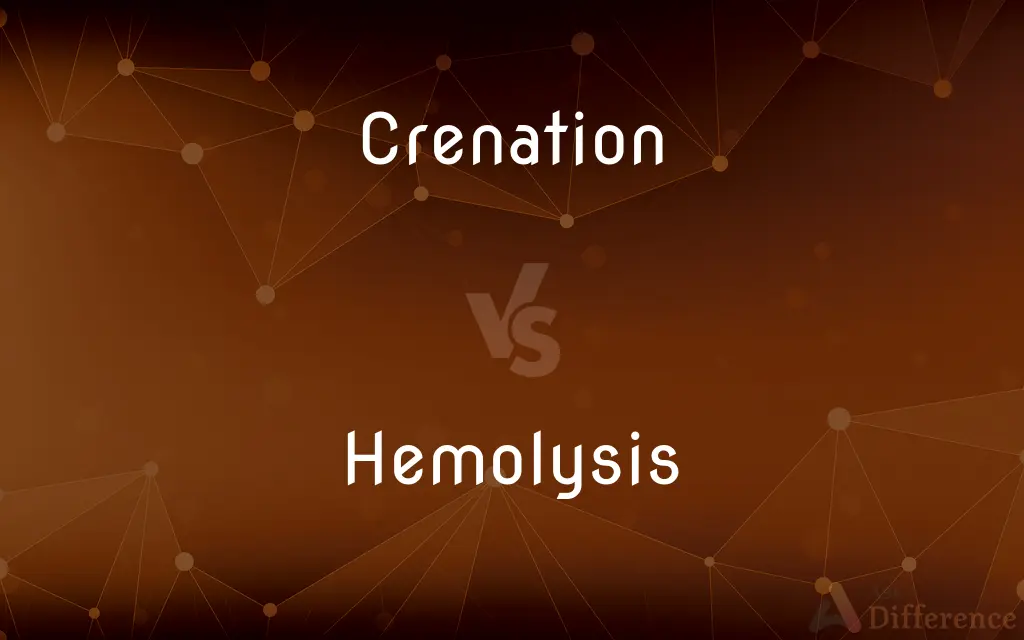Crenation vs. Hemolysis — What's the Difference?
By Tayyaba Rehman — Updated on November 3, 2023
Crenation is the shrinkage of cells in a hypertonic solution, while hemolysis is the rupture of red blood cells in a hypotonic solution.

Difference Between Crenation and Hemolysis
Table of Contents
ADVERTISEMENT
Key Differences
Crenation occurs when a cell, typically a red blood cell, shrinks due to loss of water when in a hypertonic solution. Hemolysis is the process where red blood cells burst or are destroyed, usually in a hypotonic solution where water enters the cells.
Crenation is characterized by the cell membrane of red blood cells contracting and forming scalloped or serrated edges. Hemolysis, on the other hand, results in the cell membrane of red blood cells rupturing, leading to the release of hemoglobin into the surrounding fluid.
In crenation, the environment outside the cell has a higher concentration of solutes than inside, causing water to flow out of the cell. In hemolysis, the outside environment is less concentrated, and water flows into the cell, causing it to swell and potentially burst.
Crenation is reversible if the red blood cells are returned to an isotonic solution in time. However, hemolysis is an irreversible process; once the red blood cell membrane is compromised, the cell cannot be repaired.
The term crenation is derived from the Latin word "crenatus," meaning notched or scalloped, which describes the appearance of the cell. Hemolysis comes from the Greek words "haima," meaning blood, and "lysis," meaning destruction, indicating the breakdown of red blood cells.
ADVERTISEMENT
Comparison Chart
Process
Shrinkage of cells due to osmosis in a hypertonic solution.
Bursting or destruction of cells due to osmosis in a hypotonic solution.
Solution Type
Hypertonic (higher solute concentration outside the cell).
Hypotonic (lower solute concentration outside the cell).
Result on Cells
Cells become shrunken and scalloped.
Cells swell and may burst, releasing contents.
Reversibility
Often reversible if conditions are corrected.
Irreversible; damaged cells are destroyed.
Etymology
From Latin "crenatus," meaning notched.
From Greek "haima" (blood) and "lysis" (destruction).
Compare with Definitions
Crenation
The notching or crinkling of cell membranes in high osmolarity conditions.
Crenation is easily observable when blood cells are placed in a solution with high sodium chloride concentration.
Hemolysis
A reaction in which cell membranes are compromised in a hypotonic solution.
Intravenous therapy with improper saline concentration can cause hemolysis.
Crenation
The scalloping of the edge of red blood cells in a hypertonic solution.
Under the microscope, the hypertonic solution caused the crenation of red blood cells.
Hemolysis
The breakdown of red blood cells leading to the release of their contents into the bloodstream.
A transfusion of the wrong blood type can lead to hemolysis.
Crenation
A reversible change in cell shape due to water efflux.
The biologist noted crenation as the cells adapted to the hypertonic environment.
Hemolysis
The destruction or bursting of red blood cells.
The lab technician observed hemolysis upon adding distilled water to the blood sample.
Crenation
A process where cells lose water and contract in a salty or sugary solution.
Adding too much salt to the solution can induce crenation in red blood cells.
Hemolysis
A process where hemoglobin is released into the surrounding fluid due to cell rupture.
Hemolysis can be detected by the pink or red coloration it imparts to a plasma sample.
Crenation
The cellular phenomenon observed when cells are placed in a solution more concentrated than their cytoplasm.
The student's experiment showed crenation when cells were placed in a concentrated sugar solution.
Hemolysis
An osmotic phenomenon resulting in red cell destruction.
The sudden onset of hemolysis in patients can indicate a severe underlying condition.
Crenation
Crenation (from modern Latin crenatus meaning "scalloped or notched", from popular Latin crena meaning "notch") in botany and zoology, describes an object's shape, especially a leaf or shell, as being round-toothed or having a scalloped edge.The descriptor can apply to objects of different types, including cells, where one mechanism of crenation is the contraction of a cell after exposure to a hypertonic solution, due to the loss of water through osmosis. In a hypertonic environment, the cell has a lower concentration of solutes than the surrounding extracellular fluid, and water diffuses out of the cell by osmosis, causing the cytoplasm to decrease in volume.
Hemolysis
(medicine) The destruction of red blood cells, and subsequent release of hemoglobin, at the normal end of the cell's life.
Crenation
A rounded projection, as on the margin of a shell.
Hemolysis
Hemolysis or haemolysis (), also known by several other names, is the rupturing (lysis) of red blood cells (erythrocytes) and the release of their contents (cytoplasm) into surrounding fluid (e.g. blood plasma).
Crenation
The condition or state of being crenate.
Hemolysis
The destruction or dissolution of red blood cells, with subsequent release of hemoglobin.
Crenation
A process resulting from osmosis in which red blood cells, in a hypertonic solution, undergo shrinkage and acquire a notched or scalloped surface.
Hemolysis
The lysis of erythrocytes with the release of hemoglobin; the breaking apart of red blood cells in the blood.
Crenation
(biology) The contraction of, or formation of abnormal notchings around, the edges of a cell after exposure to a hypertonic solution, due to the loss of water through osmosis, especially noticeable in red blood cells.
Hemolysis
Lysis of erythrocytes with the release of hemoglobin
Crenation
(botany) A rounded tooth on the edge of a leaf.
Crenation
The condition of being crenate.
Crenation
A rounded tooth on the edge of a leaf.
Crenation
The condition of being crenate.
Crenation
One of a series of rounded projections (or the notches between them) formed by curves along an edge (as the edge of a leaf or piece of cloth or the margin of a shell or a shriveled red blood cell observed in a hypertonic solution etc.)
Common Curiosities
Can hemolysis occur naturally in the body?
Yes, hemolysis can occur naturally due to diseases or disorders that affect red blood cells.
Does crenation affect all types of cells?
Crenation typically affects red blood cells but can affect other cells exposed to hypertonic solutions.
Is crenation harmful to cells?
Crenation can be harmful if prolonged, but it is often reversible if conditions are normalized.
Can hemolysis be induced artificially?
Yes, in laboratory settings, hemolysis can be induced for various tests and research.
Are there disorders that prevent crenation?
Certain conditions can alter cell membranes making them less prone to crenation, like spherocytosis.
What happens to cell function during crenation?
During crenation, cellular functions can be impaired due to the altered shape and reduced surface area.
What medical conditions are associated with hemolysis?
Conditions like autoimmune hemolytic anemia and sickle cell disease are associated with hemolysis.
Is crenation ever used for medical treatments?
Crenation is not typically used for treatments but is studied for understanding cellular behavior.
Is there a way to prevent hemolysis during blood transfusions?
Cross-matching blood types and careful handling of blood products can help prevent hemolysis.
Can dehydration cause crenation?
Yes, dehydration can lead to hypertonic blood plasma, potentially causing crenation of red blood cells.
What causes crenation in red blood cells?
Crenation is caused by placing red blood cells in a hypertonic solution, causing water to leave the cell.
What is a common test to detect hemolysis?
The serum haptoglobin test can detect hemolysis, as haptoglobin binds to free hemoglobin.
How does the body respond to hemolysis?
The body can respond to hemolysis by increasing red blood cell production in the bone marrow.
Can crenation be observed with the naked eye?
No, crenation is a microscopic phenomenon and cannot be observed without magnification.
Does hemolysis release any toxins?
Hemolysis releases hemoglobin, which can be toxic in large quantities if not properly cleared.
Share Your Discovery

Previous Comparison
Modernism vs. Postmodernism
Next Comparison
Ville vs. BurgAuthor Spotlight
Written by
Tayyaba RehmanTayyaba Rehman is a distinguished writer, currently serving as a primary contributor to askdifference.com. As a researcher in semantics and etymology, Tayyaba's passion for the complexity of languages and their distinctions has found a perfect home on the platform. Tayyaba delves into the intricacies of language, distinguishing between commonly confused words and phrases, thereby providing clarity for readers worldwide.














































